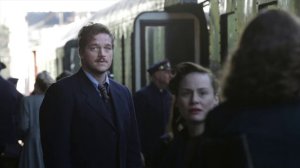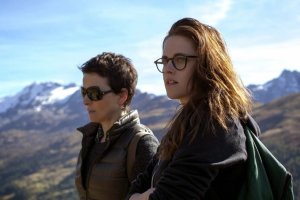By Yun-hua Chen.
Viennale 2014 continues with its good tradition of being an audience-friendly film festival, with a wide range of discussion panels, art installations, events and parties open to the public. There are tributes to Viggo Mortensen and Harun Farocki. The latter’s earlier films, which are difficult to watch on big screen, such as Zwischen Zwei Kriegen (1978) and Der Geschmack des Lebens (1979), were screened side by side with his newer works such as Nicht Ohne Risiko (2004) and Zum Vergleich (2009). Christian Petzold’s Phoenix, in which Farocki was involved as a script-writer was also selected in the festival’s feature film programme. This year’s “In Focus” section was dedicated to the works of the Algerian director Tariq Tequia. In one special programme we see a series 16 mm films organised according to themes such as sex, war, contemporariness, and amateur filmmaking, which is a timely celebration of this historic film format and its artistic possibilities especially at our time overwhelmed by pixels. In another special programme we see five of Jean-Luc Godard’s films spanning from the 1960s to 1990s, handpicked by five filmmakers who participate at this year’s Viennale. They also run in parallel to Godard’s revolutionary 3-D new feature Adieu Au Language. Following Viennale’s wonderful tradition, this is a comprehensive film festival which takes its audience from 2-D to 3-D, from film to pixel, and from Europe to the rest of the world.
Among the wide range of music-related documentaries this year, including Laura Archibald’s Greenwich Village: Music That Defined a Generation, and Ian Forsyth and Jane Pollard’s 20,000 days on Earth, there is Florian Habicht’s Pulp: A Film About Life, Death and Supermarkets. Pulp follows the band’s last concert in Sheffield, 25 years after the farewell concert in their hometown. Habicht intercuts between archival footage, footage of Pulp’s recent concert in Sheffield, and interviews of a wide range of ordinary people in Sheffield, ranging from newspaper vendor, groupies, choir members to local butchers. By filming people singing Pulp’s songs, the film attempts to create a meeting point between the song “Common People” and its source of inspiration, even some years after its original creation. What makes Jarvis’ presence in front of the camera even more interesting at the Viennale is his presence behind the camera in The Big Melt, co-directed with Martin Wallace. In this almost wordless documentary, 100 year old archival footage of steel factory workers from the British Film Institute is placed side by side with animated images explaining the process of steel production which is also about Sheffield and its mine industry. Without any commentary, the film indulges itself in the feast of images and music, which evoke the ignored and the forgotten. It is a thoughtful piece brooding over ups and downs of Sheffield, as well as our gain and loss in contemporary material life. It is a city symphony in a less expected place, and like Sheffield Doc Festival says, ‘you will never look at a fork in the same way again.’
Meanwhile, J. P. Sniadecki’s The Iron Ministry would probably make the audience ‘never sit in a train in the same way again.’ Shot entirely inside train journeys across China over the span of two years, this one-man film employs tight frames throughout the film out of lack of space. The director/cameraman behind the camera is almost completely inaudible and invisible. His presence is felt through positioning and breathing of the camera, but he remains an observer-interlocutor who is caught in the middle of chance conversation between strangers coming from different age groups, professions, birth places and ethnicities and working in various industrial towns; this is a miniature of the Chinese working-class. By filming mostly in over-crowded second class trains, where many passengers squat along narrow aisles, the film gives the underprivileged Chinese workers a stronger voice than first-class travellers in comfortable bed. Because of lack of space the camera stays very close to fellow travellers’ faces or body parts. We see a long take in which the camera follows the in-house vendor squeezing through crowds of people along the narrow aisle. Gracefully, it is a gentle portrait of these faces and body parts of fellow travellers.
In The Iron Ministry the director stays behind the camera during all the travelling, but in Our Terrible Country one of the two directors goes from behind the camera to in front of the camera. Despite constraints of financial means, number of batteries and shifting political situation, this documentary manages to consider images as a away of rendering. The film image contemplates on the role of intellectuals in a revolution, as well as what images can do or should do in front of a sensational situation such as in a civil war. It is also reconsidered how images can avoid possessing the self-exoticising quality and keep everything daily and humane in a documentary about a hyped subject matter. In a unpretentious manner this documentary stays down to earth at a time when war images are over-mediatised images around the world. An interview with the director Mohammed Ali Atassi can be found here.
This year’s Viennale was also the rare opportunity to see Tsai Ming-liang both behind and in front of the camera. Continuing with the series of fragments which recounts a Chinese Buddhist monk’s journey, starting with The Walker, Tsai’s No Form also features his walking in slow motion, embodied by his long-time collaborator Lee Kang-sheng. Lee walks firstly in a crowd in Taiwan and subsequently drifts to an all-white space with a staircase and a narrow corridor, at the end of which the monk comes face to face with his own image. This philosophical and meditative short film, again with Tsai’s trademarked framing and reflection upon perception of speed, is screened alongside with Saw Tiong Guan’s documentary on Tsai’s journey in film, Past Present. It follows Tsai Ming-liang’s journey back to Malaysia. As Tsai visits old family friends and went back to some old cinemas which have disappeared and were converted, he reminisces about his early encounter with cinemas thanks to his film buff grandparents and a time which was lost forever. While he contemplates on time, memories and complicated bonding with parents, Tsai’s colleagues such as Ang Lee, Hou Hsiao-hsien, Li Kang-sheng, Chen Shiang-chyi and Apichatpong Weerasethakul discuss the uniqueness of his works. At the same time that past and present are intertwined, Tsai’s roles as an expatriate, a son, a grandson and a renowned filmmaker are interwoven.
Some films continue with the look of European arthouse cinema, such as Olivier Assayas’ Clouds of Sils Maria. The well-crafted digressive narrative is graced by an impressive presence of Juliette Binoche, who plays a middle-aged actress Maria Enders. She fully embodies the renowned but apprehensive actress with all her complexes and psychological issues. She agrees to play in a work which makes her famous 20 years ago, but this time instead of her original role as the alluring young girl, she is offered the role of the older boss. There is real chemistry between Binoche and Kristen Stewart, which is further crystallized in the blurring between the film and the film-within-the-film, and between characters and the roles they enact. Against the backdrop of a stunning landscape in Switzerland, this film is at the same time about human psyche and a film script’s psyche of its own.
Yun-hua Chen is an independent film scholar who contributes regularly to Film International, Exberliner, online magazine of Goethe Institut, as well as academic journals.




